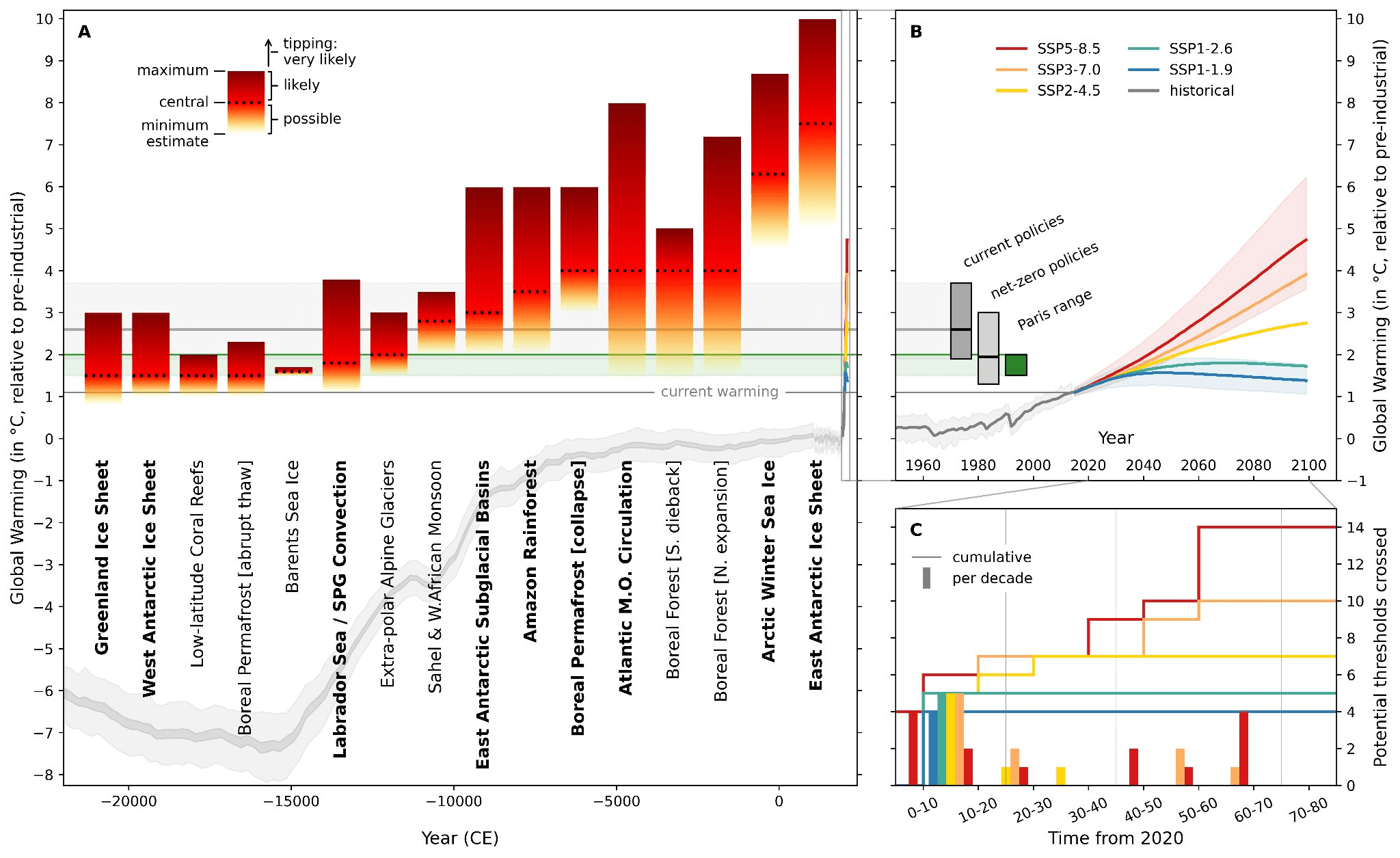Perhaps the most dangerous aspect of climate change is that the effects aren’t always linear. Higher temperatures inevitably mean more of the recently escalating droughts, floods, and fires. Sometimes, however, increased warmth can create a tipping point, from which a region, or the entire planet, cannot come back easily even if temperatures fell again. We’re likely to reach five of them if we breach the 1.5°C (2.6°F) Paris Agreement, a new study says.
Although climate scientists agree tipping points exist, they’re much less confident in predicting the temperatures required for them to occur. A paper in Science draws on 220 previously published studies to reveal the best estimates, and the uncertainty ranges, for nine globally important tipping points and seven of major regional significance.
Unsurprisingly, given the broad scope of the study, the news is mixed. However, one overall message is clear: if we don’t want to alter the world in ways that make recovery almost impossible, we need to keep temperature rise below 1.5° C, or rely on getting very, very lucky.
The tipping points discussed include some that regularly attract global attention such as the Amazon turning to grassland and Greenland melting. Others, such as the change of convection currents in the Labrador Sea, are much less well known, but all have implications beyond their immediate area.
As the accompanying chart shows, climate scientists are very confident they know how much global warmth it will take to cause the melting of ice in the Barents Sea to the point it will be hard to get it back. Less sea ice means more sunlight absorbed rather than reflected so that even if the world cooled a little again, the localized rise in temperatures would prevent reversal. This will occur if temperatures stay 1.6°C (2.9°F) above pre-industrial levels for an extended period. The world has already exceeded 1.1°C and 1.5°C is rapidly approaching.

A) Bars show the minimum (base, yellow), central (line, red), and maximum (top, dark red) threshold estimates for each tipping element. B) a palaeorecord of Global Mean Surface Temperature (GMST) over the past ~25ky and projections of future climate change. C) How many thresholds are likely to have been crossed at different points in the future based on IPCC projections Image Credit: Armstrong McKay et al. (2022).
In other cases, however, we’re like people edging into a field strewn with landmines – we know they’re there and could destroy us, but not sure how far we can go without being blown up.
The greatest uncertainty concerns the halting of the Atlantic Meridional Overturning Circulation (AMOC). Without the sinking of salty cold water that drives AMOC it is expected warm water flowing north up the Gulf Stream will slow to a trickle. This could have disastrous effects on the climate of areas around the Atlantic Basin. Assessments of the point where AMOC would reach its tipping point regard a 4-degree rise as the most likely point. Avoiding a temperature increase that big is now considered increasingly likely.
The problem, however, is the uncertainty is so great it’s possible AMOC could tip at less than 2 degrees, and every fraction of a degree warming means we’re gambling with increasingly loaded dice. We’ve already entered the uncertainty range for five of the 16 points under consideration.
“We can see signs of destabilization already in parts of the West Antarctic and Greenland ice sheets, in permafrost regions, the Amazon rainforest, and potentially the Atlantic overturning circulation as well,” said lead author Dr David McKay of the Stockholm Resilience Center in a statement.
“The world is already at risk of some tipping points. As global temperatures rise further, more tipping points become possible. The chance of crossing tipping points can be reduced by rapidly cutting greenhouse gas emissions, starting immediately.”
The study also draws attention to two other factors that can’t easily be represented statistically or in graphs like the one above. The first is that not all of these effects are driven by temperature alone. Deforestation of the Amazon for cattle farms could mean the trip wire is well below the calculated 3.5°C.
Moreover, the tipping points are not entirely independent – each is connected to the others to some extent, although some more so than others.
“Many tipping elements in the Earth system are interlinked, making cascading tipping points a serious additional concern,” Professor Ricarda Winkelmann of the Potsdam Institute for Climate Impact Research said. “In fact, interactions can lower the critical temperature thresholds beyond which individual tipping elements begin destabilizing in the long run.”
Simply deciding the world could afford to cross a few thresholds may not be an option – some would initiate others.
Source Link: Perilous Climate Tipping Points Multiply Above 1.5°C Warming, We Must Prevent That Happening